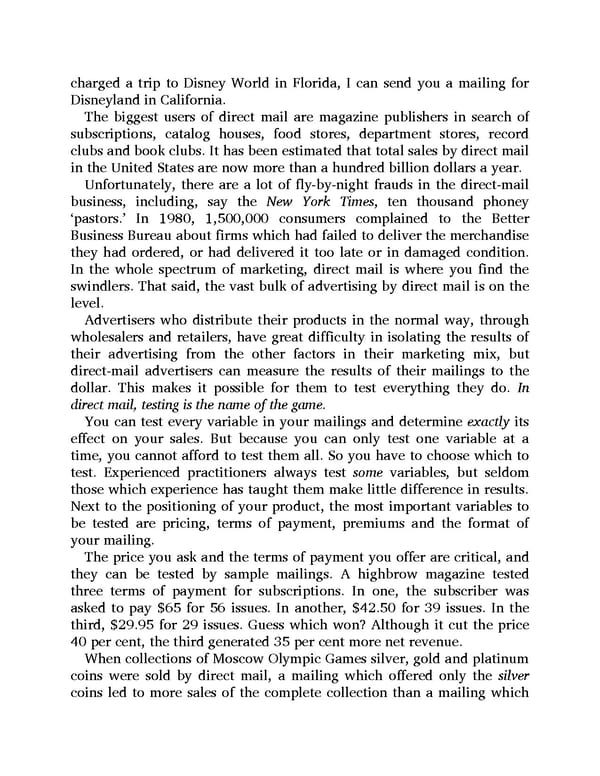charged a trip to Disney World in Florida, I can send you a mailing for Disneyland in California. The biggest users of direct mail are magazine publishers in search of subscriptions, catalog houses, food stores, department stores, record clubs and book clubs. It has been estimated that total sales by direct mail in the United States are now more than a hundred billion dollars a year. Unfortunately, there are a lot of fly-by-night frauds in the direct-mail business, including, say the New York Times, ten thousand phoney ‘pastors.’ In 1980, 1,500,000 consumers complained to the Better Business Bureau about firms which had failed to deliver the merchandise they had ordered, or had delivered it too late or in damaged condition. In the whole spectrum of marketing, direct mail is where you find the swindlers. That said, the vast bulk of advertising by direct mail is on the level. Advertisers who distribute their products in the normal way, through wholesalers and retailers, have great difficulty in isolating the results of their advertising from the other factors in their marketing mix, but direct-mail advertisers can measure the results of their mailings to the dollar. This makes it possible for them to test everything they do. In direct mail, testing is the name of the game. You can test every variable in your mailings and determine exactly its effect on your sales. But because you can only test one variable at a time, you cannot afford to test them all. So you have to choose which to test. Experienced practitioners always test some variables, but seldom those which experience has taught them make little difference in results. Next to the positioning of your product, the most important variables to be tested are pricing, terms of payment, premiums and the format of your mailing. The price you ask and the terms of payment you offer are critical, and they can be tested by sample mailings. A highbrow magazine tested three terms of payment for subscriptions. In one, the subscriber was asked to pay $65 for 56 issues. In another, $42.50 for 39 issues. In the third, $29.95 for 29 issues. Guess which won? Although it cut the price 40 per cent, the third generated 35 per cent more net revenue. When collections of Moscow Olympic Games silver, gold and platinum coins were sold by direct mail, a mailing which offered only the silver coins led to more sales of the complete collection than a mailing which
 Ogilvy on Advertising Page 205 Page 207
Ogilvy on Advertising Page 205 Page 207